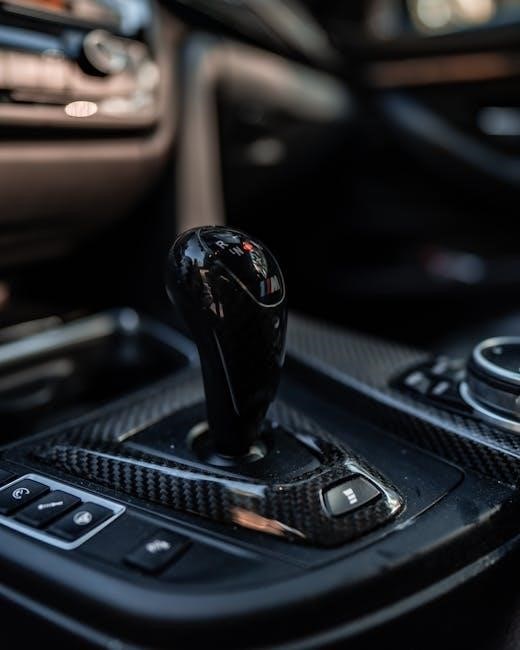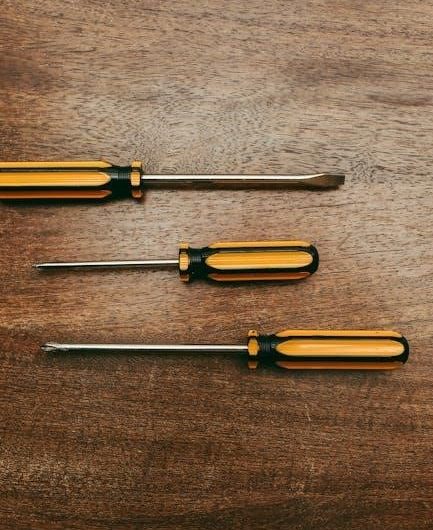
Manual transmissions in Mercedes offer precise control and driver engagement, emphasizing a connection between the driver and the vehicle. Historically, they’ve been a cornerstone of automotive performance.
Historical Overview of Manual Transmissions in Mercedes-Benz
Mercedes-Benz has a rich history with manual transmissions, dating back to the mid-20th century. These transmissions were initially simple, 4-speed units, becoming popular among driving enthusiasts. By the 1980s and 1990s, 5-speed manuals became standard, offering better performance and fuel efficiency. However, with the rise of automatics and EVs, manual transmissions have declined, now seen as a niche for purists seeking a classic driving experience.

Types of Manual Transmissions in Mercedes
Mercedes-Benz manual transmissions have evolved from early 4-speed units to modern 6-speed systems, offering enhanced performance, fuel efficiency, and smoother gear shifts over the years.
4-Speed Manual Transmissions
The 4-speed manual transmission in Mercedes-Benz vehicles was a foundational gearbox, known for its simplicity and durability. It provided smooth shifting and reliable performance, making it a popular choice in earlier models. This transmission was well-suited for city driving and moderate acceleration, offering a balance of efficiency and ease of use.
5-Speed Manual Transmissions
The 5-speed manual transmission in Mercedes-Benz vehicles marked an evolution in driving dynamics, offering improved fuel efficiency and smoother gear transitions compared to its 4-speed predecessor. This gearbox became popular in various models, providing drivers with enhanced control and performance; Its design catered to both city and highway driving, making it a versatile option for diverse driving conditions.
6-Speed Manual Transmissions
The 6-speed manual transmission in Mercedes-Benz vehicles represents a pinnacle of mechanical refinement, offering crisp shifts and optimal performance. Designed for both efficiency and responsiveness, this gearbox excels in a wide range of driving scenarios, from urban commutes to high-speed cruising. Its robust construction and precise engineering ensure durability and a smooth driving experience.

Common Problems with Mercedes Manual Transmissions
Common issues include worn clutches, fluid leaks, and shifting difficulties. Improper transmission fluid usage and high mileage often exacerbate these problems, requiring timely maintenance and repair.
Worn-Out Clutch Issues
Worn-out clutches in Mercedes manual transmissions often lead to slipping or difficulty engaging gears. Symptoms include increased stopping distances and grinding noises. Early diagnosis is crucial to prevent further damage to the gearbox. Regular maintenance and timely replacement of worn components are essential to maintain optimal performance and driver control.
Transmission Fluid Leaks
Transmission fluid leaks in Mercedes manual transmissions can lead to premature wear and potential system failure. Common causes include worn seals, damaged gaskets, or improper fluid levels. Regular inspections of the gearbox and pan gasket are essential to identify and address leaks early. Using the correct transmission fluid, as recommended by Mercedes, helps maintain system integrity and performance.
Difficult Shifting or Gearing Problems
Difficult shifting or gearing issues in Mercedes manual transmissions often stem from worn synchronizers, misaligned gear components, or insufficient transmission fluid levels. Drivers may experience resistance or grinding when changing gears. Regular fluid checks and inspections of the gearbox components are crucial to prevent such problems. Addressing these issues promptly ensures smooth operation and extends the lifespan of the transmission system.

Maintenance Tips for Mercedes Manual Transmissions
Regular maintenance is crucial for Mercedes manual transmissions. Replace transmission fluid periodically, adjust the clutch pedal, and inspect gaskets and seals for leaks to ensure smooth operation and longevity.
Transmission Fluid Replacement
Replacing the transmission fluid in a Mercedes manual transmission is essential for maintaining smooth gear operation; Use the recommended ATF type to ensure optimal lubrication. Regular fluid changes help prevent wear on internal components and maintain consistent performance. It’s advisable to refer to the owner’s manual or consult a specialist for the correct procedure and interval recommendations.
Clutch Pedal Adjustment
Clutch pedal adjustment is crucial for smooth operation of the manual transmission in Mercedes. Proper adjustment ensures the clutch engages fully, preventing wear on components. Loosen the locknut, adjust the pedal height, and tighten the locknut. Always consult the owner’s manual for specific instructions to ensure accuracy and avoid potential issues with the clutch system.
Regular Inspection of Gaskets and Seals
Regular inspection of gaskets and seals in Mercedes manual transmissions is essential to prevent fluid leaks and ensure smooth operation. Check for signs of wear, cracks, or leaks around the transmission pan, input shaft, and clutch housing. Replace damaged seals promptly to avoid costly repairs and maintain optimal performance of the manual gearbox.
Shifting Techniques for Mercedes Manual Transmission
Mastering shifting techniques enhances control and performance in Mercedes manual transmissions, ensuring smooth gear transitions and optimal driving experience behind the wheel.
Proper Acceleration and Deceleration
Proper acceleration involves smooth, gradual throttle application while shifting through gears to maintain traction and avoid wheel spin. Similarly, controlled deceleration by downshifting before braking ensures optimal engine braking and reduced wear on the braking system, enhancing overall vehicle stability and responsiveness in various driving conditions.
Downshifting for Better Control
Downshifting before turns or descents enhances control by using engine braking to slow the vehicle, reducing brake wear. It ensures smoother transitions and maintains stability, especially on winding roads or inclines. Proper downshifting prevents excessive speed and improves overall vehicle responsiveness, making it a key skill for mastering manual transmissions in Mercedes.
Smooth Shifting in Traffic
Smooth shifting in traffic requires gentle clutch engagement and gradual acceleration. Avoid riding the clutch to prevent wear and ensure a seamless transition between gears. Shifting into neutral during stops reduces strain on the transmission. This technique minimizes jerky movements, providing a more comfortable ride and better control in congested conditions.
Manual vs. Automatic Transmission in Mercedes
Manual transmissions offer enhanced driving control and engagement, while automatics provide convenience and smoother city driving. Each caters to different driver preferences and needs.
Fuel Efficiency Comparison
Manual transmissions often provide better fuel economy, especially in city driving, due to lower weight and direct engine control. Automatics, while improved, typically consume slightly more fuel. Driving conditions and driver behavior significantly impact efficiency differences between the two.
Driving Experience and Control
Manual transmissions offer enhanced driver engagement, with precise gear control and a direct connection to the vehicle. This results in a more immersive driving experience, especially on winding roads, where manual shifting allows for better speed modulation and control compared to automatic transmissions.
Cost and Maintenance Differences
Manual transmissions typically cost less than automatics, both in initial purchase and maintenance. They require less complex components, reducing repair expenses. However, regular clutch replacements can add to long-term costs. Overall, manuals remain more affordable and mechanically straightforward compared to automatics, appealing to budget-conscious drivers who prioritize simplicity and lower ownership expenses.
Troubleshooting Common Issues
Troubleshooting manual transmissions involves identifying symptoms, checking fluid levels, inspecting for worn components, and using diagnostic tools. Regular maintenance and consulting a professional are crucial.
Diagnosing Clutch Failure
Diagnosing clutch failure involves checking for slipping, unusual noises, or difficulty shifting gears. Inspect the clutch pedal for proper engagement and test for consistent performance across different speeds and loads.
Identifying Transmission Noise
Transmission noise in Mercedes manual transmissions can manifest as grinding, clunking, or whining sounds during shifting. Common signs include unusual noises when accelerating or decelerating. Inspect for loose components or worn bearings; Low transmission fluid levels or debris in the gearbox can also cause erratic sounds. Addressing these issues promptly prevents further damage and ensures smooth operation.
Checking for Fluid Leaks
Regularly inspect the Mercedes manual transmission for fluid leaks, especially around the seals and gaskets. Look for reddish-brown drops under the car or on the driveway. A low fluid level can lead to shifting issues. Addressing leaks promptly prevents costly repairs and maintains optimal transmission performance and longevity.
Future of Manual Transmissions in Mercedes
The future of manual transmissions in Mercedes looks uncertain as the brand shifts toward automatic and electric vehicles, prioritizing convenience and technological advancement over manual driving experiences.
Decline in Popularity
The decline in popularity of manual transmissions in Mercedes is evident as modern drivers favor convenience and automation. With advancements in automatic and semi-automatic technologies, fewer customers opt for manual gearboxes, leading Mercedes to focus more on these alternatives to meet market demands and preferences for smoother, hassle-free driving experiences.
Focus on Automatic and Semi-Automatic Transmissions
Mercedes has shifted focus to automatic and semi-automatic transmissions due to rising demand for convenience and advanced technology. These systems offer smoother acceleration and reduced driver effort, aligning with modern preferences. The development of dual-clutch and continuously variable transmissions highlights Mercedes’ commitment to innovation and meeting consumer needs for efficient, hands-free driving experiences.
Impact of Electric Vehicles on Manual Transmissions
Electric vehicles (EVs) are influencing the decline of manual transmissions at Mercedes. EVs typically use single-speed or multi-speed automatic systems, eliminating the need for manual shifting. This shift reflects broader industry trends prioritizing electrification and automation, challenging the relevance of manual transmissions in future Mercedes models as EVs gain dominance.
Performance and Driving Experience
Manual transmissions in Mercedes deliver enhanced driver engagement and precision, offering superior control and responsiveness compared to automatics, making every drive more exhilarating and connected to the road.
Enhanced Driver Engagement
Manual transmissions in Mercedes foster a deeper connection between driver and vehicle, requiring active participation through gear shifts and clutch control. This mechanical interaction heightens sensory feedback, making driving feel more dynamic and personal. The tactile experience of shifting gears manually enhances the overall driving satisfaction, creating a more immersive and engaging journey for enthusiasts who value precision and control.
Improved Acceleration and Responsiveness
Manual transmissions in Mercedes deliver quicker acceleration and sharper responsiveness by allowing drivers to precisely control gear shifts. This direct mechanical connection enables optimal torque delivery, especially during overtaking or climbing inclines. The ability to hold lower gears enhances responsiveness, providing a more dynamic and controlled driving experience compared to automatic transmissions.
Better Control on Winding Roads
Manual transmissions in Mercedes provide exceptional control on winding roads by allowing precise gear shifts. Drivers can hold the optimal gear, maintaining momentum and stability. The direct mechanical connection enhances responsiveness, enabling better speed management and braking control. This results in a more secure and enjoyable driving experience on twisty terrain.

DIY Projects and Modifications
Mercedes enthusiasts can enhance their driving experience with DIY projects like upgrading the clutch system and installing performance transmission fluid for smoother shifting and improved responsiveness.
Upgrading the Clutch System
Upgrading the clutch system in your Mercedes manual transmission enhances performance and durability. Replacing the stock clutch with a high-performance unit improves grip and reduces wear. Ensure compatibility with your specific model and driving demands for optimal results. Always follow manufacturer guidelines or consult a professional for installation to maintain reliability and safety.
Installing Performance Transmission Fluid
Installing performance transmission fluid in your Mercedes manual transmission enhances lubrication and heat resistance. Synthetic fluids are recommended for improved viscosity stability and protection against wear. Always drain the old fluid, replace the filter, and fill with the specified grade for optimal performance. This upgrade ensures smoother shifting and extended gearbox longevity, especially in high-performance driving conditions;
Custom Shifting Kits for Smoother Gearing
Custom shifting kits optimize Mercedes manual transmissions for precision and control. These kits often include lightweight components and adjustable gear ratios, minimizing friction and enhancing shift accuracy. Tailored to driver preferences, they improve responsiveness and reduce wear. Ideal for enthusiasts seeking refined performance, these kits can be fine-tuned for specific driving styles, ensuring a seamless and sporty experience behind the wheel.
Buying Guide for Used Mercedes with Manual Transmission
When purchasing a used Mercedes with a manual transmission, inspect the clutch, gearbox, and fluid levels. Test drive to ensure smooth shifting and check maintenance records for clutch replacements and fluid changes. Look for any signs of wear or leaks, and verify the gearshift’s functionality to avoid costly repairs later.
Checking the Clutch and Gearbox Condition
Inspect the clutch for wear by test driving and feeling for slippage or hesitation. Check the gearbox for smooth shifting and unusual noises. Look for signs of fluid leaks around the clutch and gearbox. Ensure the clutch pedal operates smoothly and fully engages. A mechanic can help verify the condition and identify potential issues before purchase.
Test Driving for Smooth Shifting
During a test drive, shift through all gears to ensure smooth transitions without hesitation or grinding. Accelerate gradually to check for clutch engagement and listen for unusual noises. Decelerate and downshift to test synchronization. Smooth shifting indicates a well-maintained transmission, while resistance or noise may signal underlying issues requiring attention.
Reviewing Maintenance and Service History
Examine the vehicle’s service records to verify regular maintenance, including clutch replacements and fluid changes. Ensure all repairs were done by certified professionals. A well-documented history indicates proper care, reducing the risk of future mechanical issues. Consistent servicing is crucial for longevity and performance of the manual transmission system in Mercedes vehicles.
 merlin home transmitter manual
merlin home transmitter manual  geography textbook activity manual pdf
geography textbook activity manual pdf  scope buddy plus user manual
scope buddy plus user manual  hibbeler mechanics of materials solution manual
hibbeler mechanics of materials solution manual  2015 buick enclave dvd player manual
2015 buick enclave dvd player manual  katalic cat feeder manual
katalic cat feeder manual  king of the underworld rj kane pdf
king of the underworld rj kane pdf  contrat de sous-location québec pdf
contrat de sous-location québec pdf  mark cousins the story of film pdf
mark cousins the story of film pdf